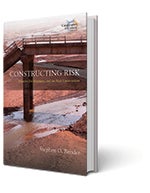Now Reading
Alumni Books

Constructing Risk
Disaster, Development, and the Built Environment
Stephen O. Bender ’74
Berghahn Books, 2021
In 1992, Hurricane Andrew devastated much of Florida, wiping out homes, businesses and infrastructure. The destruction was compounded by the absence of a uniform, statewide building code and lax enforcement of the existing building standards. But the conflicting agendas of stakeholders — including landowners, builders, real estate agents and local government officials — thwarted efforts to create a statewide code for an entire decade before the Florida Building Code was finally adopted in 2002.
It can be hard to determine who should take ownership of efforts to mitigate risk from natural disasters, architect Stephen O. Bender writes in “Constructing Risk.” But as climate change increases the likelihood of calamities such as Andrew, the stakes are rising for communities everywhere. Given the urgent need for risk reduction and preparedness, as opposed to reactive disaster relief, public and private institutions are increasingly being called upon to collaborate on measures that could prevent the worst outcomes for a given population. As Bender illustrates, those measures can include better building codes as well as land use management, development strategies and social policies that combat poverty and corruption.

Thinking With Maps
Understanding the World Through Spatialization
Bertram C. Bruce ’68
Rowman & Littlefield, 2021
Maps provide much more than the answer to the question, “Where do I turn?” In “Thinking With Maps,” Bertram C. Bruce, professor emeritus in library and information science at the University of Illinois at Urbana-Champaign, argues that maps provide context that can help us understand our lived experience, expanding our capacity to think about and participate in the world. But many people have limited map literacy, including the growing number of us who rely on our phones to tell us where to turn without bothering to look at the map itself. By treating maps as an afterthought, we’re missing out on a wealth of information and the ability to make connections across space and time. Bruce recommends that we not only start paying attention to maps but also try making them ourselves. Maps, he reminds us, can be visual representations of many things besides geographic areas, and they can be a powerful aid to memory and information processing. “A map also tells a story, which the listener can enter into,” Bruce writes. “This can be the seed for all sorts of learning.”
— Jennifer Latson
